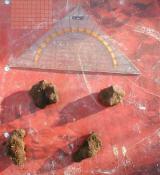Another try (2/8)
Another try
Months later I found in the state library a book on local archaeology full of maps. It turned out that in the forest I had searched the traces of old ways are still visible – though several hundred meters away from the plateau’s rim.
The wheels of the carriages had caused deep depressions in the ground still visible today. Often there are many parallel traces in a fan shape because a parallel route was opened every time the old way was worn out. One bunch of traces was directly near a small pond. Since this was possibly a resting place where items had been lost I decided to search that area.
Again, this forest was not my friend. While I found this carriage traces easily nothing was to be found with the exception of the ever present early modern horse shoe. After several hours of futile search I made a last attempt and relocated again. This time I went to the only creek in the forest as water always attracted people. The creek was some 400 m long and I had almost searched its entire length without result. Then came an iffy iron signal. I found several shapeless corroded iron pieces.
While these nondescript items do not look like much I always get excited if I find one of these. These items indicate pre 1500 iron ore processing. They consist of sponge iron, which is a very porous raw iron, and some slug. These are wonderful indicator finds, similar to musket balls for those looking for a battle scene. While the finds themselves are not impressive they indicate interesting human presence in the past, in this case iron ore processing in medieval or even antique times at this creek. Being a metal searcher I like everything connected to the early stages of the use of metal, be it sponge iron or the – even more desirable – green patinated bronze lumps from the bronze age some 3500 years ago.
(C) Thorsten Straub www.metal-detecting.de 2006-2019.
